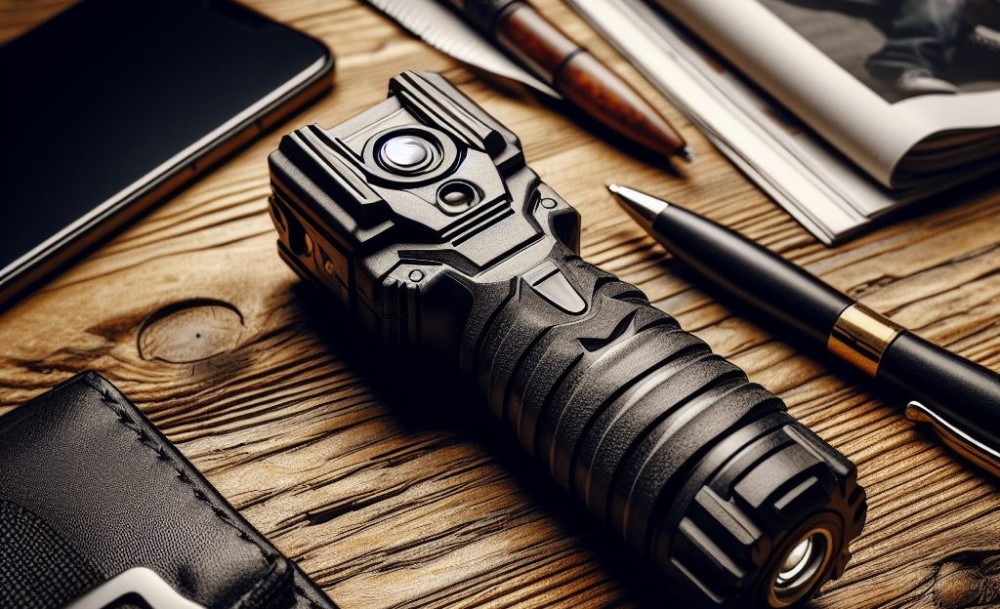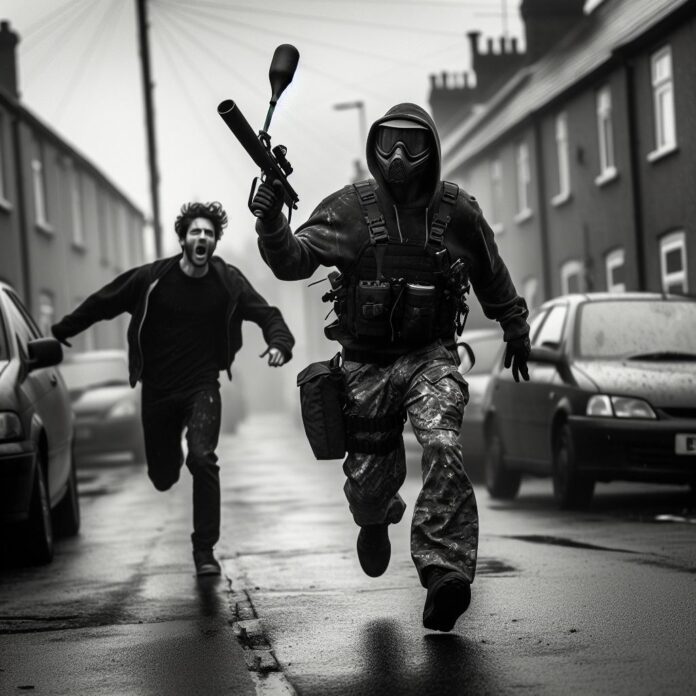Using a paintball gun for self-defense is a topic that has garnered attention and debate. While paintball guns are primarily used for recreational purposes, some individuals have considered the possibility of utilizing them for self-defense situations.
In this article, we will explore the various aspects of using a paintball gun for self-defense and analyze its effectiveness as a weapon.
To begin, we will provide an introduction to using a paintball gun for self-defense, outlining the concept and considerations involved. We will then delve into what a paintball gun is and how it works, providing a deeper understanding of its mechanics.
Legal considerations are crucial when discussing the use of a paintball gun for self-defense. We will examine the legal implications and regulations surrounding the use of these guns in different jurisdictions.
Next, we will address the question of whether a paintball gun can be an effective self-defense weapon. This section will explore factors such as accuracy, range, and the impact and deterrent effect of paintball gun shots.
However, it is important to acknowledge the limitations and drawbacks of using a paintball gun for self-defense. We will discuss the lack of lethal force, limited ammunition capacity, and potential legal and safety issues associated with these weapons.
Finally, we will provide alternatives to using a paintball gun for self-defense. This includes exploring options such as pepper spray or mace, tasers or stun guns, and firearms or other weapons, highlighting their pros and cons.
By addressing these aspects, we aim to provide a comprehensive analysis of using a paintball gun for self-defense and help readers make informed decisions regarding their personal safety strategies.
What Is a Paintball Gun and How Does It Work?

Photo Credits: Paintballbuzz.Com by Jesse Lewis
A paintball gun is a device that propels small paint-filled projectiles at high speeds. It operates by using compressed gas, typically carbon dioxide or compressed air, to create pressure that forces the paintballs out of the barrel.
The gun is equipped with a magazine or hopper that holds the paintballs and a trigger mechanism that releases them upon pulling the trigger. The paintballs are propelled by the force generated by the compressed gas, and they travel towards the target.
Paintball guns work on the principle of rapid expansion of gas. When the trigger is pulled, the compressed gas is released, which rapidly expands and propels the paintball out of the barrel.
The speed and accuracy of the paintball can be adjusted by altering the pressure of the gas and the barrel length.
It is important to note that paintball guns are designed for recreational purposes and should not be used for self-defense. They are non-lethal weapons and are intended for use in controlled environments such as paintball fields.
Paintball guns can cause bruises or welts upon impact, but they do not have the stopping power or effectiveness of traditional self-defense weapons.
To sum up, a paintball gun is a device that uses compressed gas to propel paint-filled projectiles. It operates on the principle of rapid expansion of gas to propel the paintballs towards the target.
However, it is not suitable for self-defense purposes and should only be used in controlled recreational settings.
What are the Legal Considerations for Using a Paintball Gun for Self-Defense?
Using a paintball gun for self-defense has legal considerations that must be taken into account. While paintball guns are generally considered non-lethal weapons, their use for self-defense can still have legal implications.
In most jurisdictions, the use of force in self-defense should be proportional to the threat faced. This means that if you choose to use a paintball gun for self-defense, you should ensure that the level of force used is reasonable and necessary to protect yourself from harm.
Additionally, it is vital to familiarize yourself with local laws and regulations regarding the use of paintball guns for self-defense, as these may vary from one jurisdiction to another.
Not all areas may permit the use of paintball guns in this manner, and the consequences for using them unlawfully can be severe.
Therefore, it is essential to consult local legal authorities or seek professional advice to understand the specific legal considerations for using a paintball gun for self-defense in your area.
Fact: In some jurisdictions, using a paintball gun for self-defense may be considered a form of non-lethal force and can be permissible under certain circumstances.
Can a Paintball Gun be an Effective Self-Defense Weapon?
Looking to protect yourself? Let’s explore the potential of a paintball gun as a self-defense weapon.
From its accuracy and range to the impact and deterrent effect of its shots, we’ll uncover the facts and discuss whether a paintball gun can truly hold its ground in self-defense scenarios.
So, grab your gear and join us on this exploration of paintball guns and their effectiveness for personal protection.
Accuracy and Range of a Paintball Gun
The accuracy and range of a paintball gun are crucial factors to consider when using it for self-defense.
- Accuracy: Paintball guns are designed to be accurate within a certain range. The accuracy of a paintball gun depends on various factors such as the quality of the gun, the type of barrel used, and the paintballs themselves. Higher-end paintball guns with adjustable barrels tend to offer better accuracy. It’s important to practice regularly and adjust the gun’s settings to ensure optimal accuracy.
- Range: The range of a paintball gun refers to the maximum distance it can shoot accurately. Most paintball guns have an effective range of around 50-100 feet. However, the actual range can vary depending on factors like the gun’s power, barrel length, and the type of paintballs used. It’s important to note that shooting beyond the effective range may result in decreased accuracy and velocity.
Impact and Deterrent Effect of Paintball Gun Shots

The impact and deterrent effect of paintball gun shots are of great significance when it comes to self-defense. When a paintball gun is discharged and the paintball hits its target, it can cause considerable pain and discomfort, thereby deterring the attacker.
The force behind the shot can leave visible marks on the assailant’s body, indicating that they have been struck.
In addition to the pain inflicted, the velocity at which paintballs are shot from a paintball gun contributes to its impact and deterrent effect.
Paintball guns typically have a muzzle velocity ranging from 200 to 300 feet per second (fps), and some high-end guns can even shoot up to 400 fps.
This level of velocity ensures that the paintballs travel at a high speed, enhancing their impact and the likelihood of discouraging the attacker.
Moreover, the splattering effect of the paintball upon impact also acts as a deterrent.
The burst of color and the ensuing mess it creates can startle and disorient the attacker, momentarily diverting their attention and providing the potential victim an opportunity to escape or seek assistance.
It is important to acknowledge that the impact and deterrent effect of paintball gun shots may vary depending on factors such as distance, the clothing worn by the assailant, and the individual’s pain tolerance.
Nonetheless, overall, the force and visible evidence produced by paintball gun shots can have a significant impact in deterring potential attackers.
When considering the impact and deterrent effect of paintball gun shots, it is crucial to always remember that the responsible use of a paintball gun is imperative and should be in accordance with local laws and regulations concerning self-defense and the use of non-lethal force.
What are the Limitations and Drawbacks of Using a Paintball Gun for Self-Defense?

When considering the use of a paintball gun for self-defense, it’s crucial to be aware of its limitations and drawbacks. Let’s delve into these factors to better understand the potential challenges one might face.
From the lack of lethal force to limited ammunition capacity, along with potential legal and safety issues, we’ll explore the reasons why relying solely on a paintball gun may not be the most effective choice.
We’ll also touch upon alternative options like tasers, stun guns, firearms, and other weapons that might provide more reliable defense.
Lack of Lethal Force
Using a paintball gun for self-defense has a noteworthy “lack of lethal force.” Paintball guns are specifically designed to shoot small pellets filled with paint, and while they can cause discomfort and temporary pain, their main purpose is not to be lethal weapons.
When a paintball shot hits, it might result in bruising or welts, but the likelihood of serious injury or death is highly improbable. This absence of lethality should be a significant consideration when selecting a paintball gun for self-defense purposes.
Although a paintball gun can act as a deterrent and potentially incapacitate an assailant, it’s crucial to recognize its limitations in terms of stopping power. Unlike firearms, paintball guns lack the capability to cause deadly harm.
Therefore, they might not be effective in situations where the attacker poses a substantial threat or is heavily armed.
It is of utmost importance to understand that using a paintball gun for self-defense should be a last resort and should only be employed when other non-lethal options are unavailable or impractical.
The primary purpose of a paintball gun is for recreational use, such as in paintball games or training exercises. Utilizing it as a self-defense weapon should be approached cautiously and in compliance with local laws and regulations.
Considering the absence of lethal force, individuals should thoroughly evaluate their self-defense requirements and determine if a paintball gun is the most suitable option.
It is essential to explore alternative methods like pepper spray, tasers, or stun guns, as they may offer more effective means of self-defense in certain situations.
However, personal circumstances and preferences must be taken into account when making a decision.
Limited Ammunition Capacity
The limited ammunition capacity of a paintball gun is a crucial factor to consider when using it for self-defense.
-
- A paintball gun typically features a hopper or magazine designed to hold a specific number of paintballs, usually around 200 to 300.
- This restricted ammunition capacity implies that once all the paintballs are depleted, the gun will require reloading, which takes time and exposes the user to vulnerability.
- In high-stress situations, reloading quickly and efficiently can be challenging, particularly if the user is under duress or confronted by multiple attackers.
Having a limited number of shots also necessitates accuracy, as each shot must count.
- This can be particularly difficult for inexperienced users of paintball guns or in self-defense scenarios where pressure is high.
- The restricted ammunition capacity also limits the user’s ability to sustain defense for extended periods, as they may exhaust their paintballs before neutralizing the threat.
- Individuals considering a paintball gun for self-defense should carefully evaluate the potential advantages of its non-lethal nature in comparison to its ammunition capacity limitations.
Potential Legal and Safety Issues
- When using a paintball gun for self-defense, it is important to consider potential legal issues. Familiarize yourself with local laws and regulations regarding the use of paintball guns for self-defense to avoid any legal consequences.
- Safety concerns are also a significant aspect to consider when using a paintball gun for self-defense. Improper use or neglecting safety measures can lead to injuries. Minimize the risk of accidents by learning proper handling and operation techniques. Don’t forget to wear appropriate protective equipment, such as masks and padding, to ensure personal safety.
Tasers or Stun Guns

When considering alternatives to using a paintball gun for self-defense, tasers or stun guns are an option worth exploring.
- Tasers: Tasers are handheld devices that shoot electric probes, delivering a high-voltage shock to temporarily incapacitate an assailant. They can immobilize the attacker and provide the victim with an opportunity to escape. Tasers typically have a range of around 10-15 feet, allowing for a safe distance between the user and the threat.
- Stun guns: Stun guns are handheld devices that deliver a high-voltage shock upon direct contact with an assailant. They work by temporarily disrupting the body’s nervous system, causing loss of muscle control and disorientation. Stun guns are effective when used on close quarters self-defense situations and require physical contact to be effective.
It is important to note that tasers and stun guns are classified as non-lethal weapons. They are designed to provide a means of self-defense without causing long-term harm or death.
However, the effectiveness of tasers and stun guns can vary depending on various factors such as battery charge, target location, and individual pain tolerance.
Before considering using tasers or stun guns for self-defense, it is essential to familiarize yourself with the legal regulations and restrictions surrounding their use in your jurisdiction.
Additionally, proper training and understanding of how to use them safely and effectively is crucial.
Firearms and Other Weapons
When considering self-defense options, it’s important to explore the effectiveness of firearms and other weapons.
Here are some key factors to consider:
- Firearms: Firearms, such as handguns or rifles, can be powerful self-defense tools due to their range and potential lethality. They require proper training and licensing to ensure safe and responsible use.
- Other Weapons: Other weapons, such as tasers or stun guns, can offer a non-lethal option for self-defense. They deliver an electric shock to immobilize an attacker and can be effective in disabling them temporarily.
- Pepper Spray or Mace: These chemical sprays irritate the eyes, nose, and skin, causing temporary incapacitation. They are easy to use and widely available for self-defense purposes.
It’s important to note that the effectiveness of firearms and other weapons for self-defense can vary depending on the situation, the user’s proficiency, and the attacker’s intent or level of aggression.
To ensure safety and legal compliance, consider the following:
- Adequate training: Seek proper training and education on the safe handling and use of firearms and other weapons. This training should emphasize self-defense scenarios and legal considerations.
- Legal regulations: Familiarize yourself with the applicable laws and regulations regarding the possession and use of firearms and other weapons in your jurisdiction. This includes obtaining the necessary permits or licenses.
- Responsible storage: Store firearms and other weapons securely and out of reach from unauthorized individuals, especially if there are children in the household. Follow local laws regarding safe firearm storage.
Always prioritize personal safety and consider consulting with professionals or experts in self-defense to determine the most suitable option for your specific circumstances.
It’s important to understand that using firearms or other weapons for self-defense carries potential risks and responsibilities that should not be taken lightly.
Frequently Asked Questions
Can you use a paintball gun for self-defense?
Yes, paintball guns can be used for self-defense as they provide a non-lethal tool to deter threats without the inherent dangers associated with firearms or machetes.
What types of ammunition can a paintball gun shoot?
A paintball gun can shoot various types of ammunition such as hard rubber, pepper spray, PVC nylon, and iron dust balls.
How can paintball guns be beneficial for self-defense?
Paintball guns can be beneficial for self-defense as they can inflict pain or bruising on attackers, reducing their mobility and giving you time to call the police. They can also use different types of ammunition for better defense.
What are the precautions when using a paintball gun for self-defense?
When using a paintball gun for self-defense, it is important to aim for unprotected areas of the attacker’s body, such as the arms, legs, or stomach. Additionally, sensitive areas like the eyes, genitals, neck, and head can be aimed at to distract or disable the attacker.
Are there any limitations or problems when using paintball guns for self-defense?
Some limitations of using paintball guns for self-defense include lack of accuracy, low strength compared to standard guns, and less reliability in carrying them outside the home.
What are the legal considerations for using a paintball gun for self-defense?
The legality of using paintball guns for self-defense depends on the state. Carrying a paintball gun without permission can be illegal, and there are restrictions on carrying and displaying imitation firearms in public places. Additionally, minors may require parental consent to purchase or own a paintball gun.

